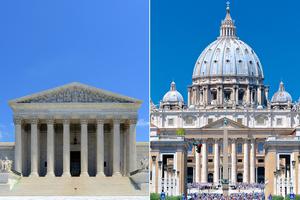Supreme Court’s NY Decision Is a Blow for Religious Freedom
COMMENTARY: The decision not to intervene and immediately block the New York COVID-vaccine mandate is a disappointing move.

This past Monday afternoon the Supreme Court, for the second time in the last two months, declined to halt a state COVID-vaccine mandate for health-care workers with religious objections. The Court’s decision not to intervene and immediately block the New York state mandate is a disappointing move, given the Court’s generally “pro-religious liberty” track record in reviewing pandemic-related restrictions.
A regulation issued by New York State Department of Health requires all health-care workers in the state to be vaccinated against COVID-19 unless they qualify for a medical exemption. The regulation does not contain a religious exemption. Health-care workers who lose their jobs because of their refusal to be vaccinated — regardless of their reasons — are ineligible for unemployment insurance benefits.
Twenty doctors and nurses with religious objections challenged the mandate in two separate lawsuits. They claim that New York is violating their First Amendment rights.
In papers filed with the Supreme Court, they explain their sincerely held religious belief against abortion in any form and their objection to receiving the vaccine because it has depended upon abortion-derived fetal cell lines in its production or testing. They also acknowledge that many other religious believers feel differently.
These doctors and nurses are arguing that New York must be prevented from enforcing the mandate against them and seeking immediate relief while their cases are being reviewed.
In one of the cases, the lower court granted such relief, concluding that New York’s “intentional change in language is the kind of religious gerrymander” that violates the First Amendment. The other court came out differently, denying the request for an injunction without issuing an opinion. In a combined judgment, the 2nd Circuit Court of Appeals rejected the claims entirely and dissolved the injunction issued by the lower court.
Without issuing an accompanying opinion, a six-justice majority refused to block the mandate while litigation in the cases continues. Justice Neil Gorsuch, joined by Justice Samuel Alito, would have put the mandate on hold until the Supreme Court can fully take up the challengers’ case. Justice Clarence Thomas indicated that he would have granted the challengers’ application but did not join the Gorsuch dissent.
When New York’s vaccine mandate for health-care workers was first announced, then-Gov. Andrew Cuomo promised a religious exemption. After Cuomo was replaced by Kathy Hochul, she announced a proposed revised mandate that eliminated the exemption. Hochul admitted that the decision to remove the exemption was made “intentionally.”
Religious exemptions would no longer be available, she reasoned, because there was no “sanctioned religious exemption from any organized religion.” In fact, she said, organized religions are “encouraging the opposite.”
To those Catholic objectors, Hochul said that “everybody from the Pope on down is encouraging people to get vaccinated.” When visiting a Baptist church in Harlem, Hochul asked, “How can you believe that God would give a vaccine that would cause you harm?” She added: “That is not truth. Those are just lies out there on social media.” The day before the mandate went into effect, Hochul said again that individuals who resist the vaccine “aren’t listening to God and what God wants.” Such statements, noted Gorsuch in his dissent, “give rise to more than a ‘slight suspicion’ that New York acted out of ‘animosity [toward] or distrust of’ unorthodox religious beliefs and practices.”
“No one seriously disputes that, absent relief, the applicants will suffer an irreparable injury,” explained Gorsuch. “Not only does New York threaten to have them fired and strip them of unemployment benefits. This Court has held that “[t]he loss of First Amendment freedoms, for even minimal periods of time, unquestionably constitutes irreparable injury.”
In Gorsuch’s assessment, the “record practically exudes suspicion of those who hold unpopular religious beliefs. That alone is sufficient to render the mandate unconstitutional. …” He continued by explaining that even if New York’s actions were not steeped in animus, the mandate will neither qualify as “neutral” — as it “was specifically directed at the applicants’ unorthodox religious beliefs and practices.” Nor is the mandate “generally applicable” — as it “prohibits exemptions for religious reasons while permitting exemptions for medical reasons.”
Consequently, New York must show that its mandate satisfies strict scrutiny. Even if the state has a compelling interest, Gorsuch was unconvinced that denying religious exemptions was the only option.
He said, “It seems that nearly every other State has found that it can satisfy its COVID-19 public-health goals without coercing religious objectors to accept a vaccine.”
A majority of the Supreme Court at the end of October similarly rejected a request by health-care workers in Maine for immediate temporary relief from a vaccine mandate with a broad medical exemption but none for religious objectors. Justice Amy Coney Barrett, joined by Justice Brett Kavanaugh, wrote a concurring opinion insisting that the Court should not rush into proceedings “without benefit of full briefing and oral argument.”
I wrote at the time that “this Supreme Court has allowed a draconian vaccine mandate to take effect is a baffling development.” Neither Barrett nor Kavanaugh explained their reasons for again joining the majority in denying injunctive relief for objecting medical professionals.
A large number of Americans have taken the COVID-19 vaccine. I am among them. And many of us consider ourselves to be religious. Our Constitution’s protection for the religious beliefs of Americans is not limited to those that are shared by a majority of believers but simply for those with sincerely held beliefs.
So while Monday’s order was disappointing, we must still hope, as Justice Gorsuch wrote in his dissent from Monday’s order, that the Court’s ruling “will not be the final chapter in this grim story.”
















